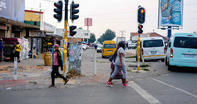Beneath Layers of Clothing or Body Fat
We tend to picture food insecurity in its most frightening form: the emaciated appearance of someone whose body has been whittled down to a macabre frame, where prolonged starvation has stretched skin drum-taut over bone, and the face is a death mask.

The images from Somalia and northern Kenya during 2011's droughts in the Horn of Africa tend to exemplify the face of food insecurity. But food insecurity is far more elusive than this, particularly in our cities.
Food and nutritional insecurity can hide beneath layers of clothing or body fat. Someone strolling down the street of the city might look plump and rounded but can still be undernourished, even if there is not the day-to-day pain of prolonged hunger. This is why food security in our cities is a hidden, invisible problem, according to Dr Jane Battersby at the University of Cape Town's Department of Environmental and Geographical Sciences.
Hunger and Malnutrition
'There are two things happening here. There's hunger and there's malnutrition,' says Battersby. 'It's feasible that a large portion of the population is chronically malnourished. And it isn't evident to the eye. People can look healthy and live relatively functional lives while still being malnourished.
' When food insecurity arrives in the countryside, says Professor Daniel Maxwell, research director for food security and complex emergencies at the Feinstein International Center, it manifests in the shape of famine, which paints itself in broad swathes across a community - it is easy to spot.
In the city, though, it looks quite different because food insecurity in the urban context is not linked with shortages of food, but rather the inability of families and households to access the food that is already present in the city in relative abundance. In response, families will adopt a number of idiosyncratic responses in order to cope, many of which are invisible'.
By Leonie Joubert